Li-FT initiates 45,000 meter drill program at the Yellowknife Lithium Project, NWT
June 7, 2023 – Vancouver, B.C., Li-FT Power Ltd. (“LIFT” or the “Company”) (CSE: LIFT) (Frankfurt: WS0) is pleased to report the start of a 45,000 meter drill program that began June 2, 2023 at its Yellowknife Lithium Project located to the east of Yellowknife, Northwest Territories. The current drill program is targeting seven outcropping spodumene-bearing pegmatite dyke complexes that are within 10 kilometers of an all-season highway (Figure 1, Road Access Group).
Drilling will begin by targeting areas that, based on historic trench sample results, returned the highest lithia grades from outcropping pegmatites. The Fi Southwest and Fi Main pegmatites will be the first targets to be drilled (Figure 2). The Company plans to drill each pegmatite target at 100 meter by 100 meter centers to a vertical depth of 300 meters. This is expected to provide sufficient sample density to enable estimates for inferred resources by mid-2024.
Francis MacDonald, CEO of Li-FT comments “We are thrilled to have started the drill program at our Yellowknife Lithium Project. This is one of the largest exploration drill programs for lithium globally, which we believe is justified by the impressive outcropping exposures of spodumene-bearing pegmatites across the portfolio that have been reported to have potentially economic grades at surface from work completed in the 1970s and 1980s. We believe that this drill program will show the scale and potential of the Yellowknife Pegmatite Province and put us well on our way to delivering a maiden resource estimate.”
Fi Southwest & Fi Main Pegmatite Dyke Targets
LIFT plans to drill 16,075 meters over 79 diamond drill holes to a vertical depth of 300 meters at the Fi targets.
The Fi area is comprised of two northeast trending dykes that have a cumulative strike length of 3,300 meters (Figure 4a). The Fi Southwest dyke is the shorter and wider of the two dykes with a total strike length of 1,100 meters and an average outcropping width of 21 meters. The dyke has a 540 meter-long central segment that dips steeply to the southeast and contains 5-30% spodumene (Figure 4b). In 1975, fourteen trenches were completed across the dyke, as shown in Figure 4a below. The Fi Main dyke is located 250 meters to the northeast of Fi Southwest and crops out over a total distance of 2,200 meters. The pegmatite dips steeply to the west-northwest and consists of two branching dyke segments each averaging 10 meters in width. In the central part of the dyke, where it branches, there is a 440m-long section with 5-30% spodumene (Figure 4b). Here, the dykes widen to 15m. In 1956, ten trenches were excavated in the area covering 440m of the dyke’s strike length. The trenches returned up to 21.9 meters of 1.34% Li2O (average of 1.3% Li2O over 14.8 meters)1.
A bulk sampling program for metallurgy was completed in 1987 by Equinox Resources. Five 230 kilogram samples were taken from the Fi area which returned an average head grade of 1.33% Li2O1.
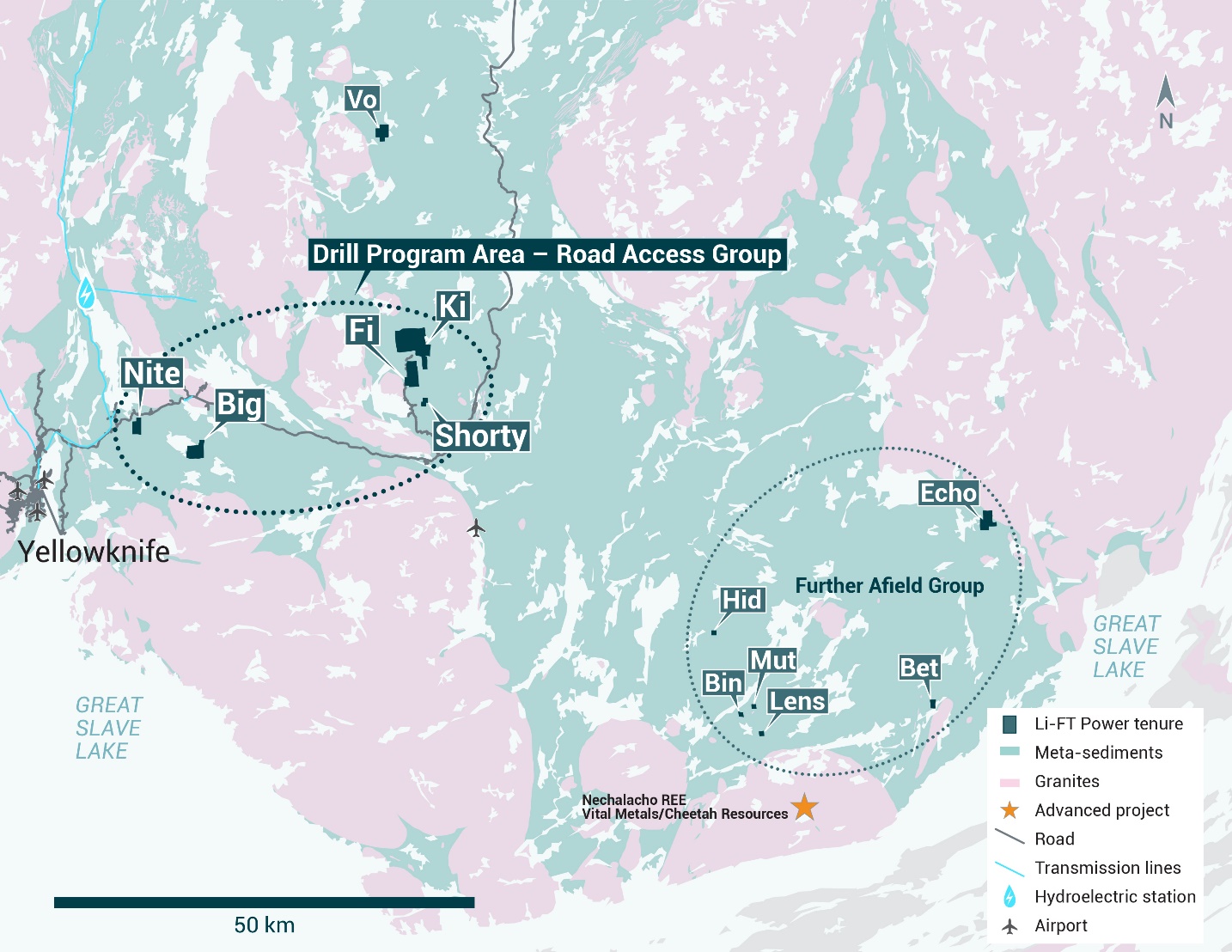
Figure 1 – Location of LIFT’s Yellowknife Lithium Project. Drilling will focus on the Road Access Group of pegmatites which are located to the east of the city of Yellowknife along a government-maintained paved highway.
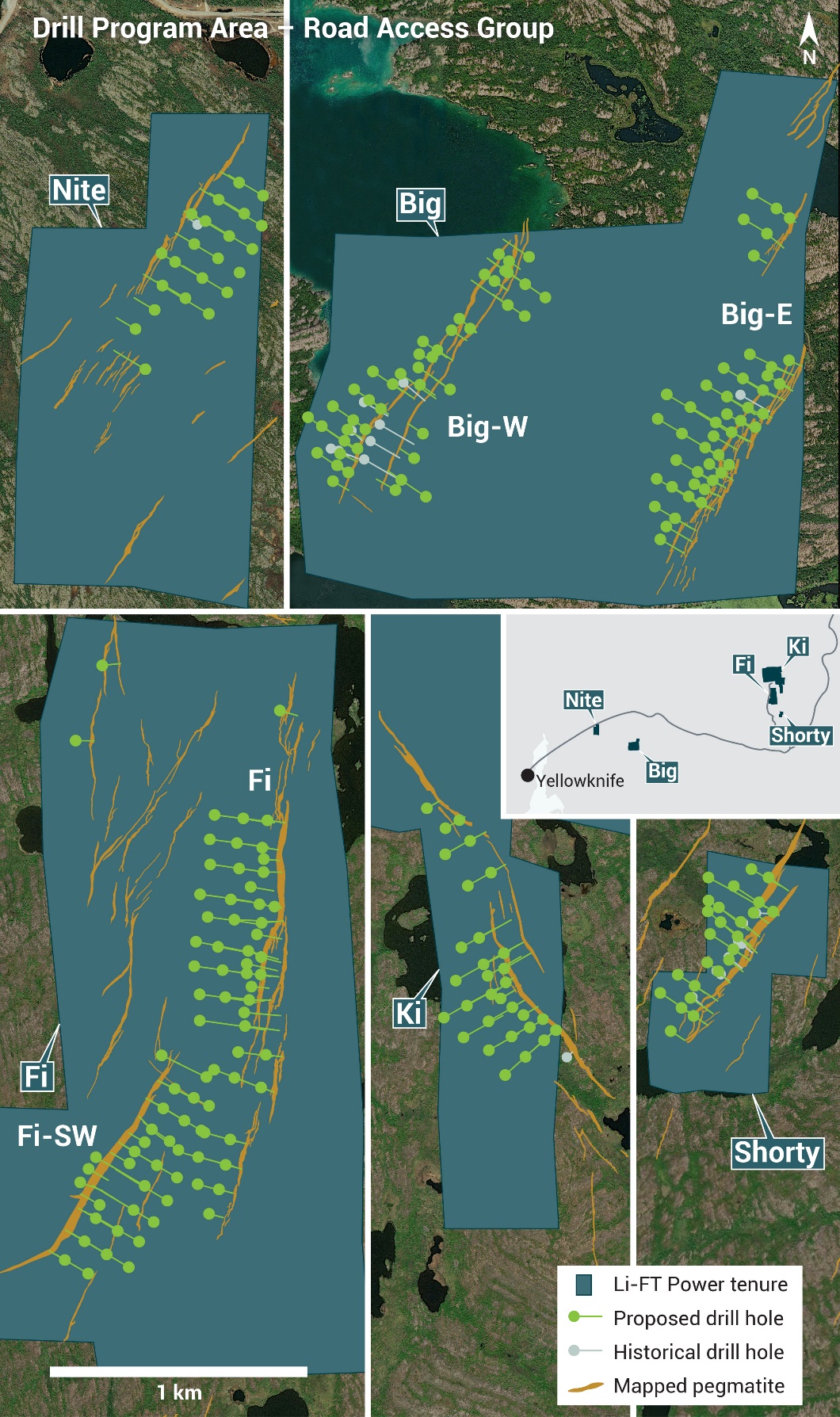
Figure 2 – Road Access Pegmatites drill plan for 2023. 45,000 meters of drilling is planned on the 7 target dykes. The drilling will be completed on 100m-spacing to a vertical depth of 300m.
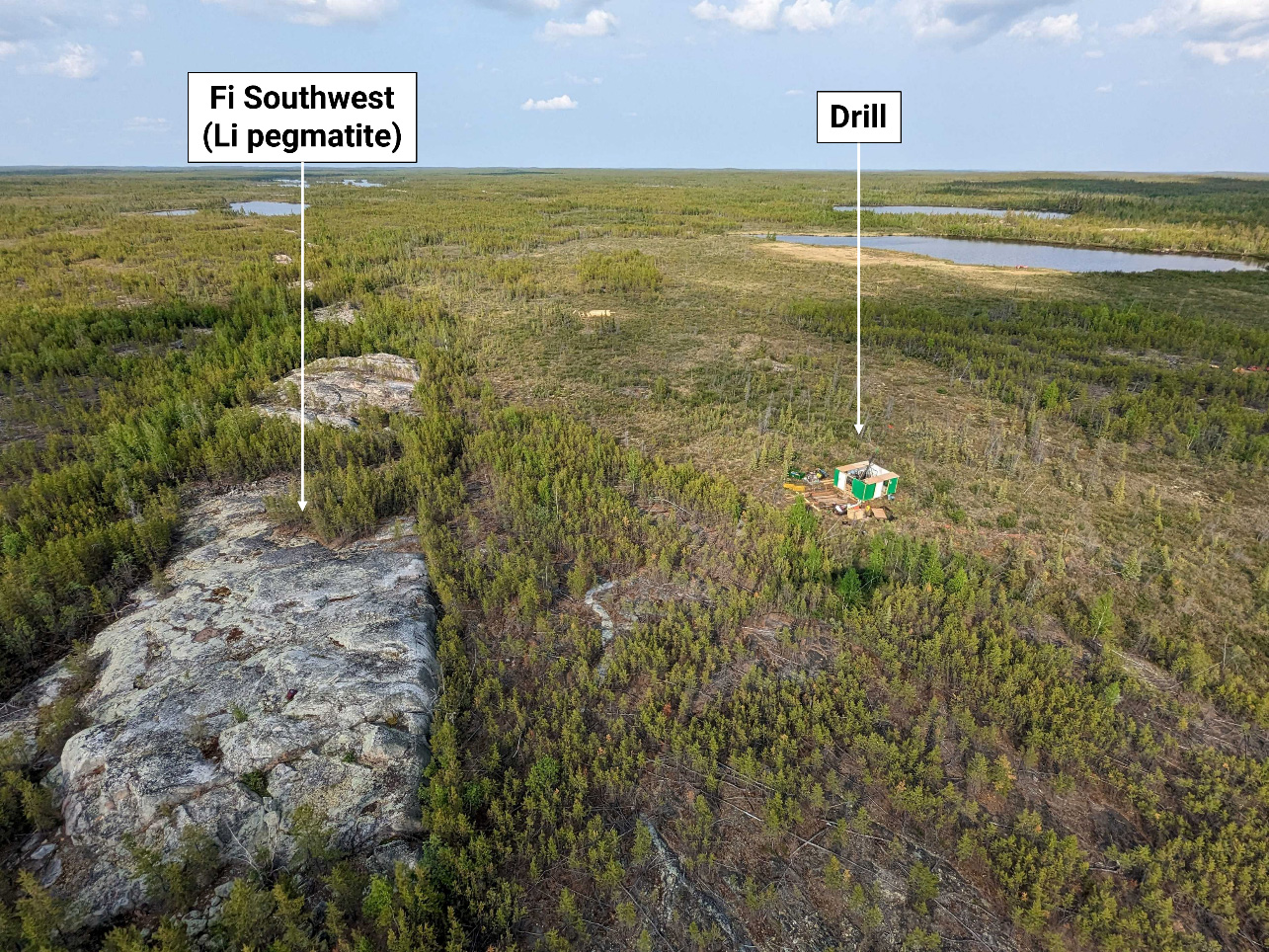
Figure 3 - Fi Southwest pegmatite with diamond drill set up. The first drill hole at Fi Southwest is targeting the extensions of high-grade spodumene recorded in historic channel sampling data1.
Ki Pegmatite Dyke Target
LIFT plans to drill 5,545 meters over 32 diamond drill holes to a vertical depth of 300 meters at the Ki pegmatite.
The Ki pegmatite is a steeply dipping set of dykes that trends on surface for 1,400 meters and has an average outcropping width of 12 meters (Figure 5a). Spodumene is abundant where detailed mapping has occurred within a 350 meter long segment (Figure 5b). In 1978 two diamond drill holes tested the Ki dyke to a depth of 50 meters below surface. Both holes intercepted spodumene-bearing dykes with an average grade of 1.58% Li2O over 13.7 meters (Figure 5c)1. The Ki dyke extends to the northwest for another 600 meters; this portion has not received any systematic sampling, but recent mapping by LIFT confirms the presence of spodumene within the dyke for at least 400 meters.
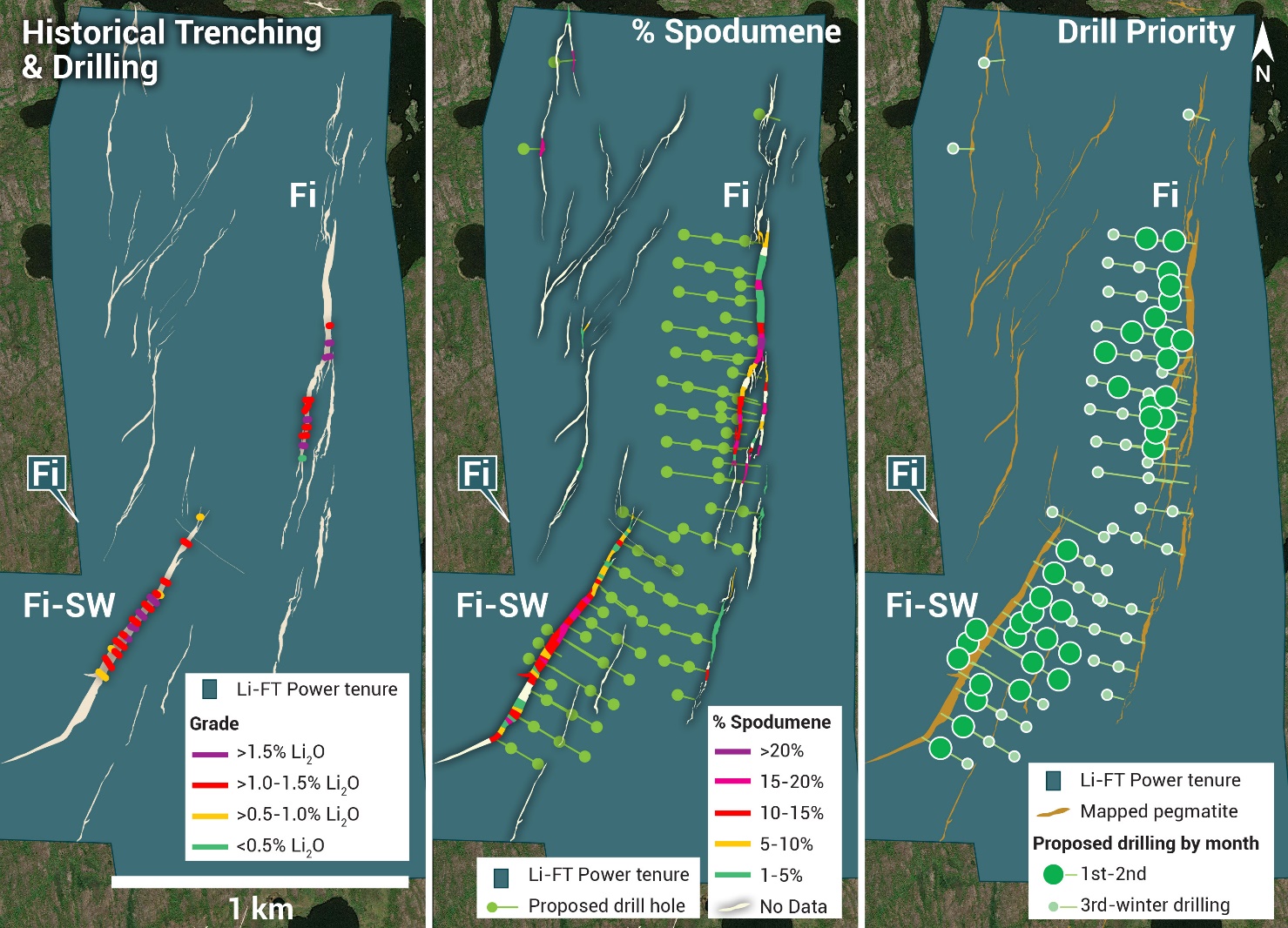
Figure 4 – Fi-Southwest and Fi-Main pegmatites. a) shows the segments of the SW and Main dykes trenched in the 1950’s. The dyke has not been drilled. No follow-up drilling was completed on the target. b) Spodumene crystal counts c) Prioritized 100m-spaced drill plan testing dike extents to 300m below the surface.
Shorty Pegmatite Dyke Target
LIFT plans to drill 4,445 meters over 25 diamond drill holes to a vertical depth of 300 meters at the Shorty pegmatite.
The Shorty pegmatite is a steeply dipping dyke that is exposed for 800 meters and has an average outcropping width of 25 meters (Figure 6a). Spodumene is most abundant over a 400m segment of the central part of the pegmatite where it makes up to 30% of the dyke (Figure 6b). In 1975, ten closely spaced trenches along a 330 meter segment of the central part of the dyke returned up to 7.8m of 1.67% Li2O (average of 1.1% Li2O over 21m). In 1987, diamond drilling below the trenches intercepted pegmatite dykes 170m below surface with intersects of up to 25.85 meters at 1.15% Li2O1.
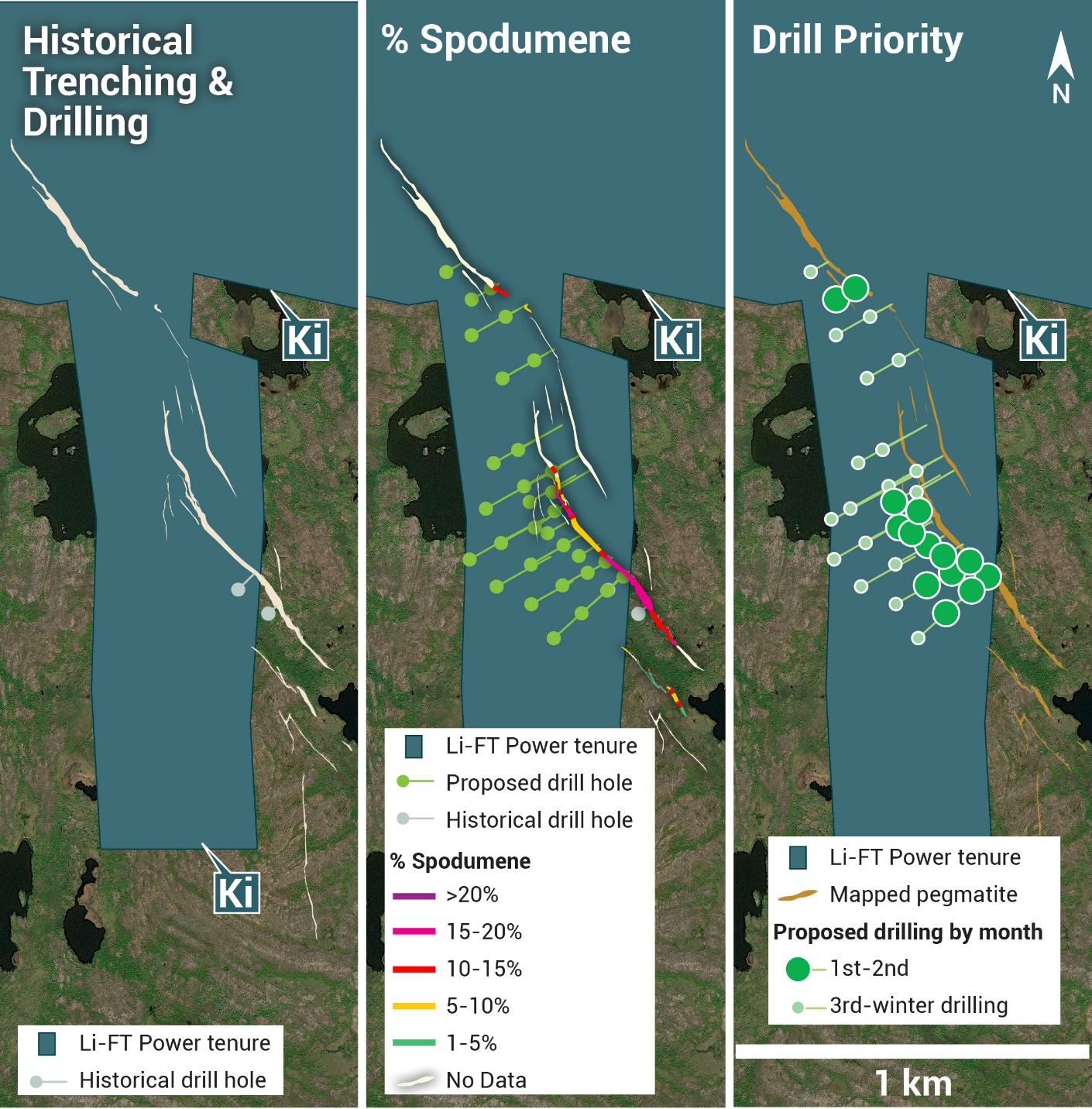
Figure 5 – Ki pegmatite a: Historical drilling. No historical trenching was conducted on the dyke. Two holes were drilled at the southeast end of the Ki dyke averaging 1.58% Li2O over 15m1. b: Spodumene crystal counts. c: Prioritised drill plan. Drilling will follow-up on historical drilling intercepts testing over 1,000m of strike-length where dyke is widest and highest grade.
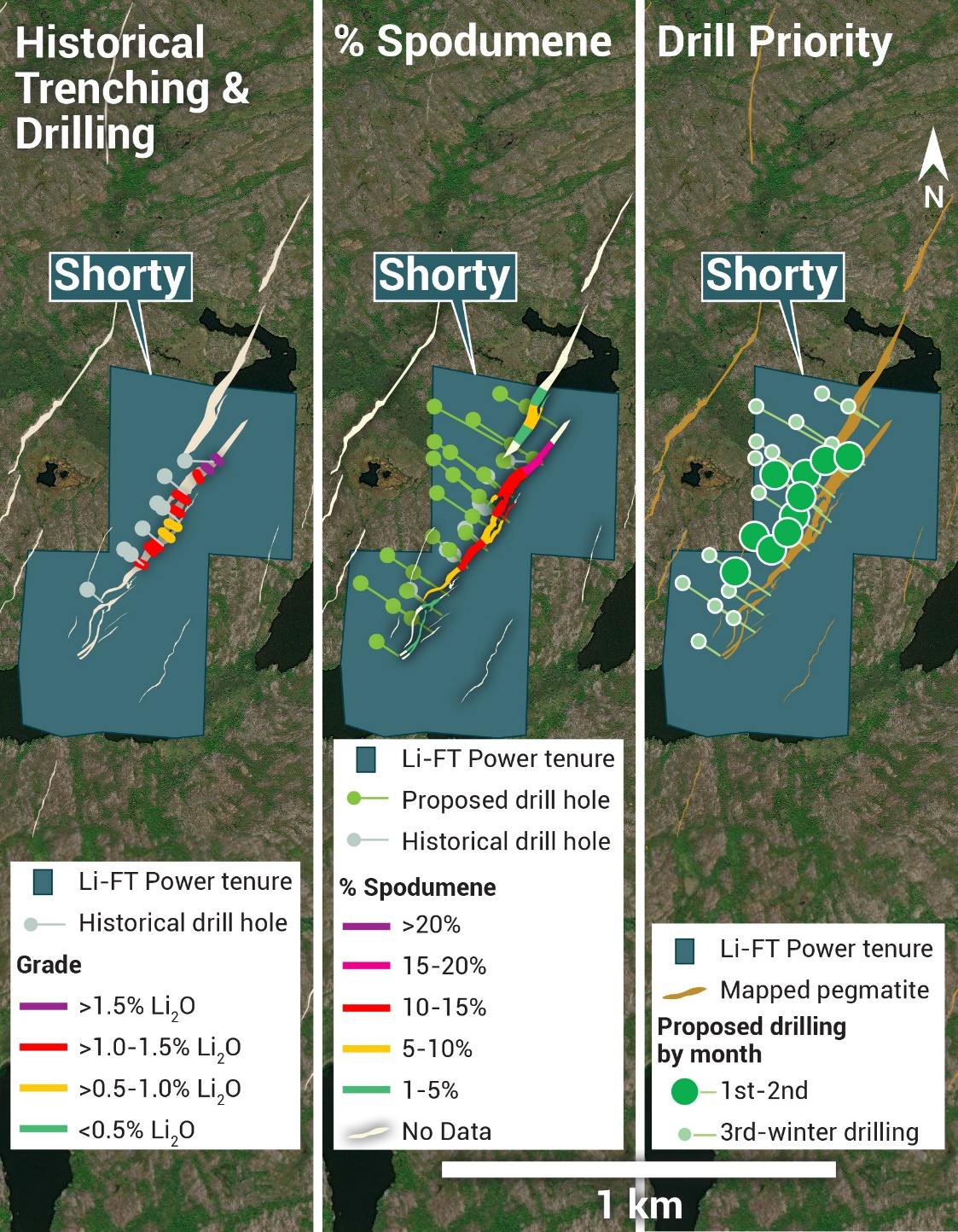
Figure 6 – Shorty pegmatite. a: Historical drilling and trenching. b: Spodumene crystal counts c: Prioritised drill plan Drilling will test 700m of strike at 100m-spacing to a depth of 300m.
Big-East Pegmatite Dyke Target
LIFT plans to drill 7,790 meters over 46 diamond drill holes to a vertical depth of 300 meters at the Big-East target.
The Big-East dyke swarm is 1,200 meters long within a corridor that is 120 meters wide. It consists of 2 principal dykes that average 6m in width (Figures 7a-b)1. The pegmatite has a 350m long central section where spodumene makes up 5-30% of the dyke (Figure 7b). In 1956-57, thirty-three trenches covering this section returned up to 12.7m of 1.72 Li2O (avg. of 1.4% Li2O over 7.3m for each of the dykes; Figures 7b). In 1978, three holes were drilled across the dyke swarm to confirm the mineral potential estimate from the 1950’s.
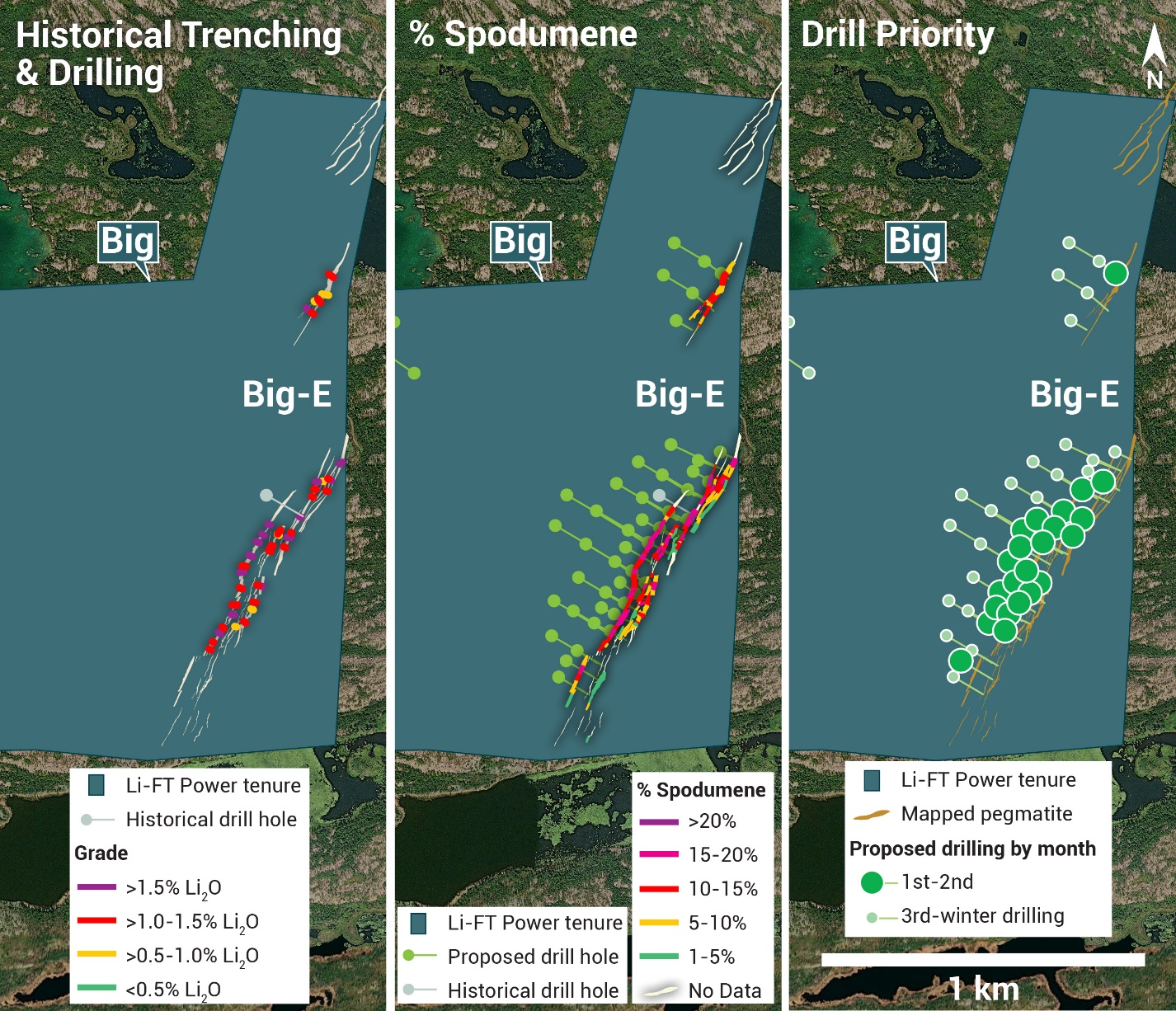
Figure 7 - Big-East pegmatite. a: Big-E Pegmatite shows historical trenching and drilling. A single hole has been drilled over 1,200m of strike length intercepting pegmatites dikes up to 14.5m1. b: Spodumene crystal counts map. c: Prioritised drill plan will drill will test below best trenches and spodumene crystal counts over 1,200m to vertical depth of 300m.
Although there is no surviving assay data, the logs show that wide spodumene-bearing dykes (up to 14.5m) are present to 122m below surface1. The drilling has been prioritised to start in areas where dykes are widest and highest grade on surface (Figure 7c). The drill plan is designed to test the continuity of the dykes over 1,000m, and to a vertical depth of 300m below the surface.
Big-West Pegmatite Dyke
LIFT plans to drill 6,240 meters over 45 diamond drill holes to a vertical depth of 300 meters at the Big-West target.
The Big-West dyke swarm is 1,300 meters long within a corridor that is 120 meters wide. It is made up of two principal subparallel dykes each averaging 6m in thickness (Figure 8a).
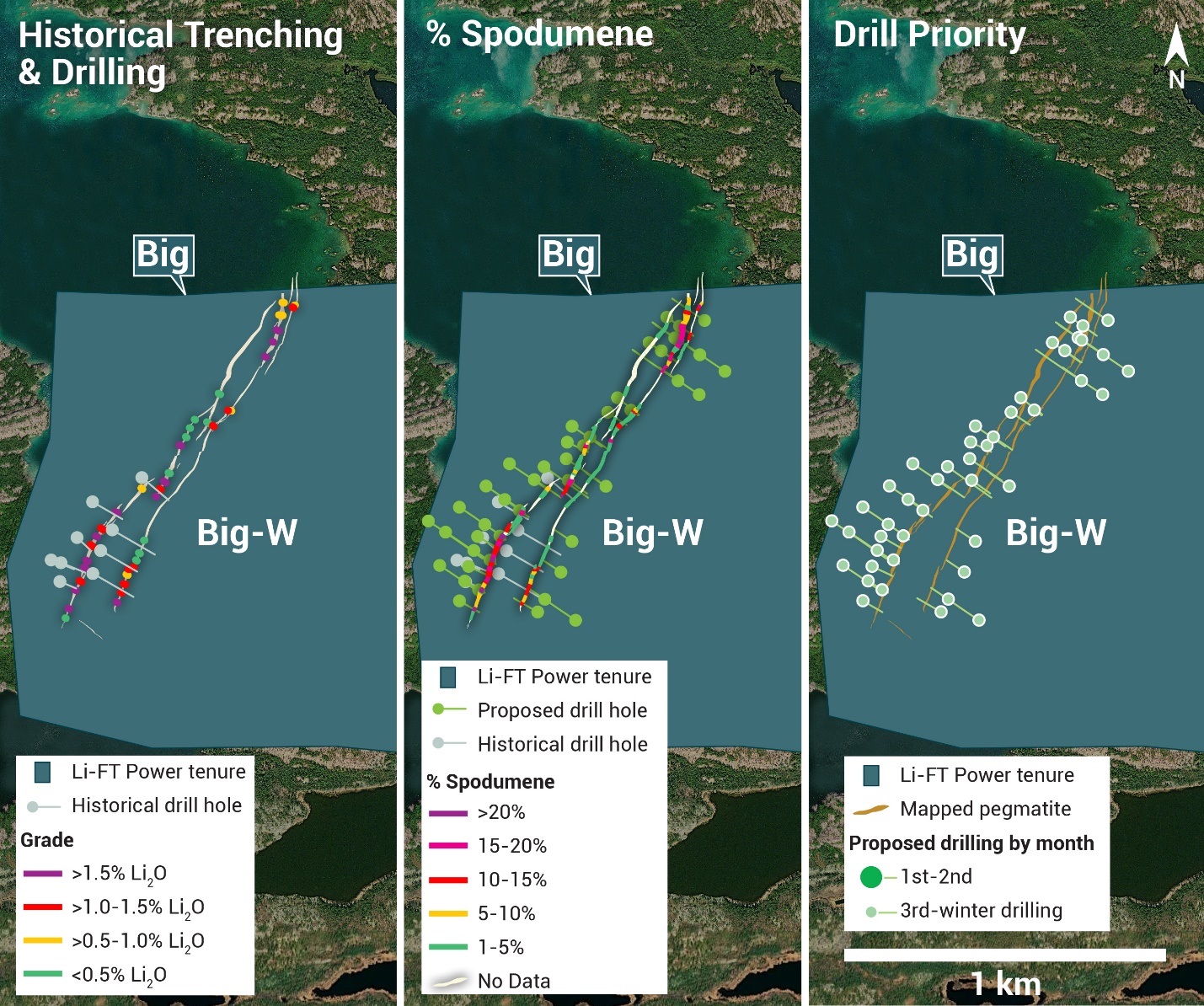
Figure 8 – Big-West pegmatite. a: Historical drilling and trenching. Only fragments of the drill database remain, but pegmatite dykes up to 14m were logged up to 149m from surface1. b: Spodumene crustal counts. c: Prioritised drill plan. The drilling will test to 300m below surface at 100m-spacing.
The best spodumene percentages are observed at the northeast and southwest ends of the swarm (Figure 8b), where spodumene constitutes 5-30% of the dykes. In 1956 and 1957, thirty-nine trenches were cut at intervals along the entire strike length of the dyke swarm, returning up to 4.8m of 2.2% Li2O (avg. 4.4m of 1.1% Li2O for each of the two dykes). In the same year, nine diamond drill holes were drilled across the dyke swarm at its southwest end. Only fragments of the historical drill data remain, but logs show that pegmatite dykes extend as far as 150 meters below surface with an average width of 7 meters. Although assay data is lost, the 1950’s, drilling indicates that wide, spodumene-bearing pegmatites are present 150 meters below surface1. Li-FT’s drilling program will test a total of 1,300m of strike length to a depth of 300m (Figure 8b & 8c).
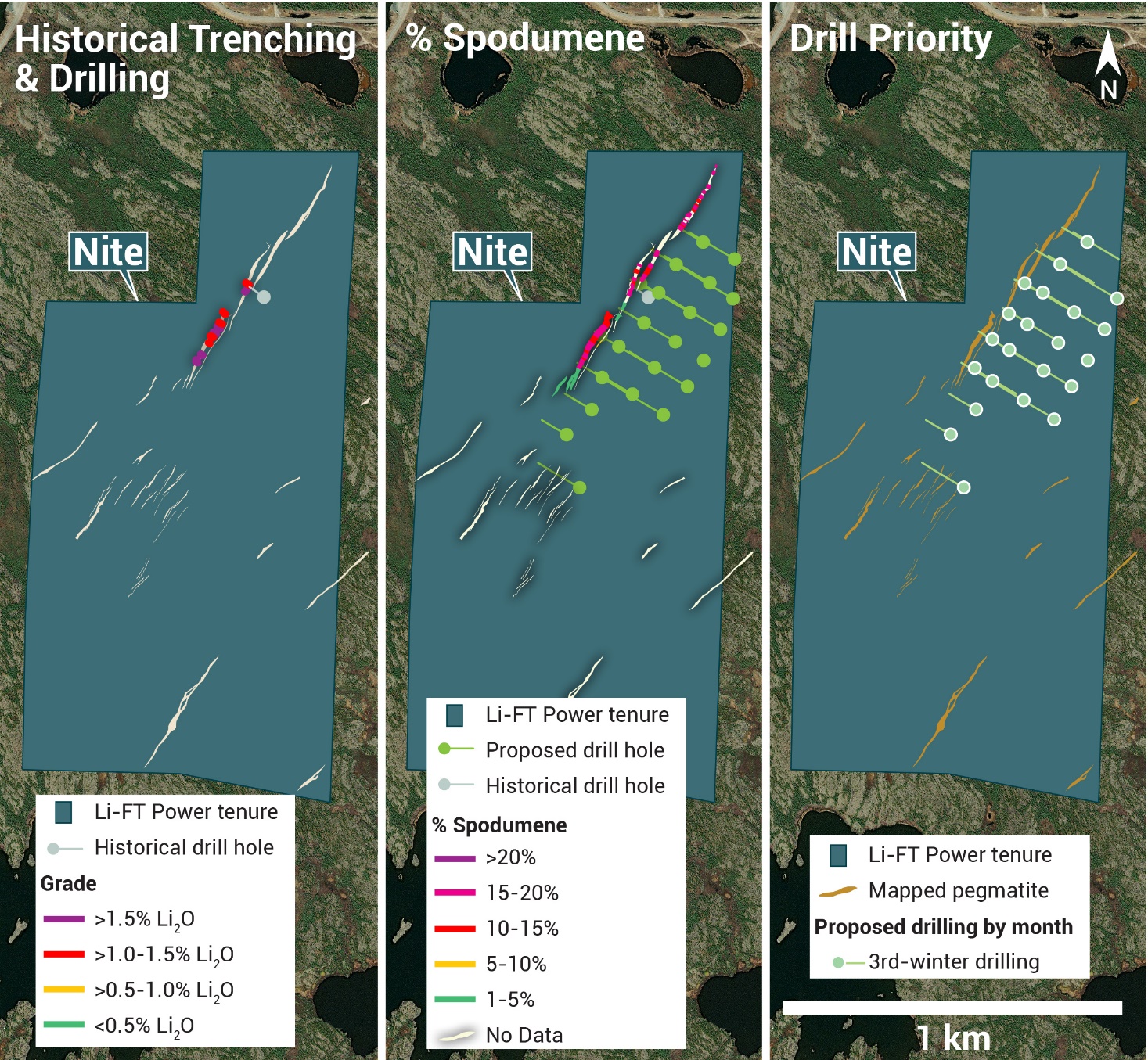
Figure 9 – Nite Pegmatite. a: Historical drilling and trenching. b: Spodumene crystal counts c: Prioritised drill plan will test 900m of strike at 100m-spacing to a pittable depth a 300m.
Nite Pegmatite Dyke Target
LIFT plans to drill 4,560 meters over 26 diamond drill holes to a vertical depth of 300 meters at the Nite pegmatite.
The Nite pegmatite is northeast-trending and dips steeply to the southeast. The dyke has a total strike-length of 1,300m with an average outcropping thickness of 7 meters (Figure 9a). The dyke has three, 150m-long segments where spodumene constitutes 5-30% of the dyke (Figure 9b). Closely spaced historical trenching over the central segment of the dyke returned up to 12.2m of 1.36 Li2O (average of 1.57% Li2O over 7.1m; Figure 9). In 1981 a single diamond drill hole was drilled below the trenches intersecting 9 meters of 1.83% Li2O in a pegmatite dyke at 58 meters below surface (Figure 9a)1.
Road Access Group and Further Afield Group Exploration
Li-FT has recently conducted a 50 meter line spaced airborne magnetics and Versatile Time Domain Electromagnetic (VTEM) survey over the Road Access Pegmatite group (Figure 1). These data will be combined with detailed ground-based induced polarisation and ground penetrating radar surveys planned for the summer. These data will in turn be used to understand the dykes’ geophysical properties for enhanced brownfield targeting of resource dyke extensions in three dimensions. Li-FT will also recommence exploration activities at the Further Afield Pegmatite Group (Figure 1), with trenching, mapping, and sampling planned for summer of 2023.
Exploration Agreement with Yellowknives Dene First Nation
Li-FT is pleased to announce it has entered into a definitive Exploration Agreement with the Yellowknives Dene First Nation.
Performance Share Units Grant
The Company will, effective June 6, 2023, grant certain consultants a total of 75,000 Performance Share Units (“PSUs”). The PSUs will vest on a ’significant’ sale of the Yellowknife Lithium Project.
References
1 NI 43-101 TECHNICAL REPORT On the YELLOWKNIFE LITHIUM PROJECT NORTHWEST TERRITORIES, CANADA (December 30, 2022) – Thomas Hawkins, PhD, P.Geo. Filed on SEDAR on January 13, 2022
Qualified Person
The disclosure in this news release of scientific and technical information regarding Li-FT Power’s mineral properties has been reviewed and approved by Carl Verley, P.Geo., Vice-President, Exploration of Li-FT Power and a Qualified Person as defined by National Instrument 43-101 Standards of Disclosure for Mineral Projects (NI 43-101). No QA/QC review is available in relation to historical sampling and drilling on the Yellowknife project and results have not been verified by a qualified person as defined by NI 43-101. Past sampling and drilling results are not necessarily indicative of future results or performance from the Yellowknife property.
About Li-FT
Li-FT is a mineral exploration company engaged in the acquisition, exploration, and development of lithium pegmatite projects located in Canada. The Company’s flagship project is the Yellowknife Lithium Project located in Northwest Territories, Canada. Li-FT also holds three early-stage exploration properties in Quebec, Canada with excellent potential for the discovery of buried lithium pegmatites, as well as the Cali Project in Northwest Territories within the Little Nahanni Pegmatite Field.
For further information, please contact:
Francis MacDonald
Chief Executive Officer
Tel: + 1.604.609.6185
Email: [email protected]
Website: www.li-ft.com
Cautionary Statement Regarding Forward-Looking Information
Certain statements included in this press release constitute forward-looking information or statements (collectively, “forward-looking statements”), including those identified by the expressions “anticipate”, “believe”, “plan”, “estimate”, “expect”, “intend”, “may”, “should” and similar expressions to the extent they relate to the Company or its management. The forward-looking statements are not historical facts but reflect current expectations regarding future results or events. This press release contains forward looking statements. These forward-looking statements are based on current expectations and various estimates, factors and assumptions and involve known and unknown risks, uncertainties and other factors.
Forward-looking statements are not a guarantee of future performance and involve risks, uncertainties and assumptions which are difficult to predict. Factors that could cause the actual results to differ materially from those in forward-looking statements include the continued availability of capital and financing, and general economic, market or business conditions, including the effects of COVID-19. Forward-looking statements contained in this press release are expressly qualified by this cautionary statement. These statements should not be read as guarantees of future performance or results. Such statements involve known and unknown risks, uncertainties and other factors that may cause actual results, performance or achievements to be materially different from those implied by such statements. Although such statements are based on management's reasonable assumptions, there can be no assurance that the statements will prove to be accurate or that management’s expectations or estimates of future developments, circumstances or results will materialize. The Company assumes no responsibility to update or revise forward-looking information to reflect new events or circumstances unless required by law. Readers should not place undue reliance on the Company’s forward-looking statements.
Neither the Canadian Securities Exchange (the “CSE”) nor its Regulation Services Provider (as that term is defined in the policies of the CSE) accepts responsibility for the adequacy or accuracy of this release.

